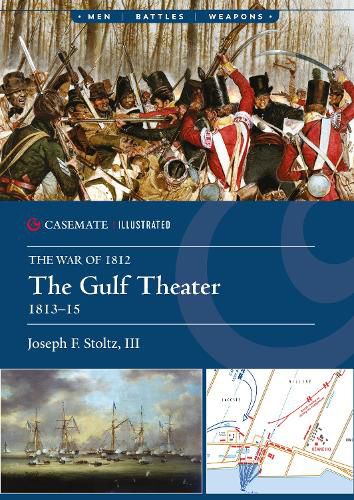Readings Newsletter
Become a Readings Member to make your shopping experience even easier.
Sign in or sign up for free!
You’re not far away from qualifying for FREE standard shipping within Australia
You’ve qualified for FREE standard shipping within Australia
The cart is loading…






While most of the fighting of the War of 1812 raged along the Canadian border, the Gulf of Mexico eventually emerged as a critical battleground. The struggle for control of the Mississippi River and the port city of New Orleans became a high-stakes contest, with both the United States and Great Britain recognizing the region's strategic and economic importance. The Mississippi was the main artery for trade and communication in the trans-Appalachian west, and New Orleans, positioned at the river's mouth, was vital for controlling the region's commerce. For Britain, capturing the city would not only cripple the American economy but also provide a bargaining tool during peace negotiations. For the United States, safeguarding New Orleans was essential to securing its western territories and preventing foreign powers from gaining a foothold on its southern frontier. The fighting in the Gulf Theater also reflected broader geopolitical tensions. Spain's declining hold on Florida and Louisiana complicated the region's dynamics, as did Britain's support for Native American resistance to U.S. expansion. The Creeks and other southeastern tribes were drawn into the conflict, with devastating consequences for their communities. The campaigns in the Gulf culminated in the battle of New Orleans, where Andrew Jackson's forces decisively repelled a British invasion. Although the battle occurred after the Treaty of Ghent had been signed, it cemented U.S. control over the region and boosted national confidence in the war's aftermath. This illustrated volume examines key episodes in the theater including the battles of Fort Bowyer, the capture of Pensacola, the fighting at New Orleans and the battle of Fort St. Philip, and situates these events within the broader context of U.S. territorial ambitions and Native American resistance. AUTHOR: Joseph F. Stoltz III is a historical consultant and author. He spent fives years as the Director of Leadership Programs at Mount Vernon. He was the Rowan Postdoctoral Fellow in Military History at the United States Military Academy 2013?14, and was the associate editor of The West Point History of Warfare. He received his Ph.D. from Texas Christian University and his master's and bachelor's degrees from the University of New Orleans. His Ph.D. dissertation examined the role of the battle of New Orleans in American memory and culture over the past two centuries. 80 photographs, illustrations and maps
$9.00 standard shipping within Australia
FREE standard shipping within Australia for orders over $100.00
Express & International shipping calculated at checkout
While most of the fighting of the War of 1812 raged along the Canadian border, the Gulf of Mexico eventually emerged as a critical battleground. The struggle for control of the Mississippi River and the port city of New Orleans became a high-stakes contest, with both the United States and Great Britain recognizing the region's strategic and economic importance. The Mississippi was the main artery for trade and communication in the trans-Appalachian west, and New Orleans, positioned at the river's mouth, was vital for controlling the region's commerce. For Britain, capturing the city would not only cripple the American economy but also provide a bargaining tool during peace negotiations. For the United States, safeguarding New Orleans was essential to securing its western territories and preventing foreign powers from gaining a foothold on its southern frontier. The fighting in the Gulf Theater also reflected broader geopolitical tensions. Spain's declining hold on Florida and Louisiana complicated the region's dynamics, as did Britain's support for Native American resistance to U.S. expansion. The Creeks and other southeastern tribes were drawn into the conflict, with devastating consequences for their communities. The campaigns in the Gulf culminated in the battle of New Orleans, where Andrew Jackson's forces decisively repelled a British invasion. Although the battle occurred after the Treaty of Ghent had been signed, it cemented U.S. control over the region and boosted national confidence in the war's aftermath. This illustrated volume examines key episodes in the theater including the battles of Fort Bowyer, the capture of Pensacola, the fighting at New Orleans and the battle of Fort St. Philip, and situates these events within the broader context of U.S. territorial ambitions and Native American resistance. AUTHOR: Joseph F. Stoltz III is a historical consultant and author. He spent fives years as the Director of Leadership Programs at Mount Vernon. He was the Rowan Postdoctoral Fellow in Military History at the United States Military Academy 2013?14, and was the associate editor of The West Point History of Warfare. He received his Ph.D. from Texas Christian University and his master's and bachelor's degrees from the University of New Orleans. His Ph.D. dissertation examined the role of the battle of New Orleans in American memory and culture over the past two centuries. 80 photographs, illustrations and maps